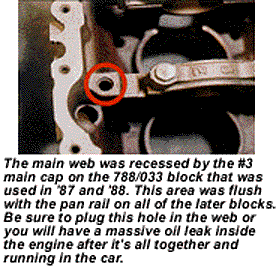 The Quad 4 had four valves per cylinder, tuned intake and exhaust manifolds, no distributor, no plug wires, lightweight rods and pistons to reduce shaking forces, and a crank with eight counterweights that was designed to reduce noise, vibration and harshness (NVH) and bearing wear. It didn’t have an A.I.R. pump or an EGR system, but it still managed to pass all the emissions tests.
The Quad 4 had four valves per cylinder, tuned intake and exhaust manifolds, no distributor, no plug wires, lightweight rods and pistons to reduce shaking forces, and a crank with eight counterweights that was designed to reduce noise, vibration and harshness (NVH) and bearing wear. It didn’t have an A.I.R. pump or an EGR system, but it still managed to pass all the emissions tests.
Even though it was a big four cylinder, it didn’t come with balance shafts because the engineers who designed the Quad 4 were convinced that it really didn’t need them, probably by the bean counters who didn’t want them to spend the extra money.
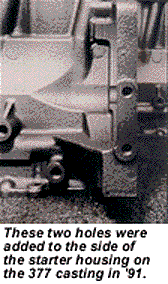 Ten years later, hindsight says the Quad 4 was historically significant, but not for all of the right reasons. The Quad 4 never lived up to its promise because it didn’t have enough low end torque to satisfy the average American car buyer, and it was too rough and noisy once it started making some serious horsepower.
Ten years later, hindsight says the Quad 4 was historically significant, but not for all of the right reasons. The Quad 4 never lived up to its promise because it didn’t have enough low end torque to satisfy the average American car buyer, and it was too rough and noisy once it started making some serious horsepower.
It has had its share of problems, too, so it has been constantly “revised” and “improved” ever since it was introduced in an ongoing effort to get it right and make it more successful in the market. The current 2.4L Quad 4 has evolved into an engine that is actually quite pleasant to drive, but it’s almost too late, because it’s due to be phased out when GM’s all new DOHC engines are introduced in a couple of years.
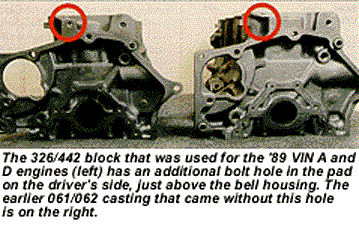 Over the past 12 years, Olds has had to deal with leaking head gaskets and cracked heads, along with a variety of oiling problems and several other glitches ranging from timing chain noise to stripped splines on the water pump drive. There have been a number of changes that were meant to improve performance and durability, too, including the addition of balance shafts to reduce NVH.
Over the past 12 years, Olds has had to deal with leaking head gaskets and cracked heads, along with a variety of oiling problems and several other glitches ranging from timing chain noise to stripped splines on the water pump drive. There have been a number of changes that were meant to improve performance and durability, too, including the addition of balance shafts to reduce NVH.
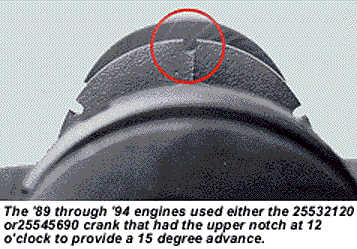 Our extensive research shows there are actually a total of six different blocks, three cranks, three rods, seven heads, four cam housings, four front covers and three oil pumps used on these engines from 1987 through 1995, and that doesn’t include the changes that were made for the 2.4L engine! It’s no wonder that everyone seems confused about what goes where, when and why.
Our extensive research shows there are actually a total of six different blocks, three cranks, three rods, seven heads, four cam housings, four front covers and three oil pumps used on these engines from 1987 through 1995, and that doesn’t include the changes that were made for the 2.4L engine! It’s no wonder that everyone seems confused about what goes where, when and why.
So, here’s our best take on the Quad 4 with our thanks to the people at Consolidated Manufacturing, Hutchinson, KS, along with several other friends in the industry. There have been lots of changes that have created several different combinations, so take good notes if you want to know how to build these engines the right way the first time.
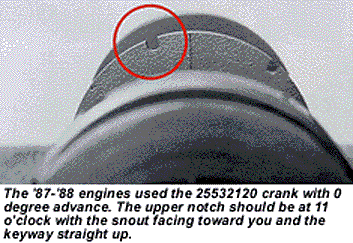
BLOCKS
1987-’88 VIN D – The original block for the Quad 4 was either a 22535788 or a 22534033 casting. It was used for the VIN D engines in ’87 and ’88. There is a recessed area between the inside of the pan rail and the outer edge of the #3 main cap that is unique to these blocks.
1989 VIN D – A slightly different block was used for the VIN D engines in ’89. It had a 22538061 or 22538062 casting number and came with one small internal change – the main web next to the #3 main cap was now flush with the pan rail instead of being recessed as it had been on the earlier blocks.
This web has a threaded hole in it that intersects with one of the main oil galleries, but we have never seen anything bolted to it, so it appears that the earlier 788/033 blocks with the recessed main web could be used instead of the later block. However, the GM reman program for the Quad 4 specifies two different applications for these blocks, so it’s probably a good idea to keep them separate.
1989-’90 VIN A (H.O.) and 1990 VIN D – The next block showed up in late ’89 for the new H.O. engine. It was either a 22539326 or a 22545442 casting and it came with two important changes: 1) There was another hole drilled in the pad on the back corner of the block on the driver’s side, right above the flange for the bell housing and 2); There were coolant passages added between the siamesed cylinders, just below the deck surface. You can tell the difference between these later blocks and the earlier ones because there are two teardrops between each cylinder instead of the plain, round holes that were found on the earlier blocks.
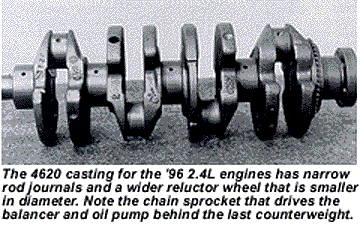
1991 VIN A (H.O.) and 1991 VIN D – In 1991, there were two more bolt holes drilled and tapped on the side of the starter housing perpendicular to the pan rail for a brace or a mount of some kind. This new block is a 24570377 casting. It appears that the earlier 326/442 blocks could be converted by drilling and tapping these two holes if you were short of the later blocks, but be sure to check it out carefully before you try it.
1992-’94 VIN A (H.O.), VIN D and VIN 3 SOHC – GM began using a “torque axis mount” in ’92 to help quiet things down in the engine compartment, so there was another new casting that came with a heavy duty, reinforced, triangular mount on the front of the block. It had thicker webs and larger (12mm) bolt holes. Look for a block with either a 24570661 or a 24572927 casting number.
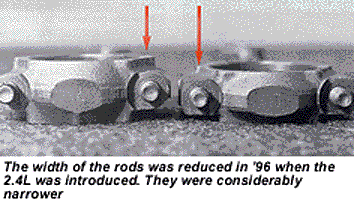
1995 VIN D – The 2.3L Quad 4 block was revised once more in ’95. This time there were additional holes drilled in the main webs for the balance shaft assembly that was added to reduce noise, vibration and harshness. And, the two holes in the “ears” on the back of the block were no longer drilled; it’s a 24574400 casting.
1996 VIN T – The 2.3L Quad 4 became a 2.4L with a smaller bore and a longer stroke in ’96, so the block was modified again. There were additional bolt bosses added on the side of the block so both the alternator and the air conditioning compressor could be mounted directly to the block. The vent system was changed, the crank sensor was moved, the holes on the side of the starter mount were moved up higher, and the ear on the right rear corner of the block was no longer there. Consequently, it’s an all new block with a 24574250 casting number.
CRANKS
There have been four different cranks used in the 2.3L Quad 4 besides the stroked version that came in the 2.4L in ’96. They can all be identified by the casting number except for the original casting that came in two flavors.
1987-’88 VIN D – The original crank was a 25532120 casting. The notches on the reluctor wheel were located at 0° when the engine was introduced in ’87, but by late ’88 or model year ’89, depending on who you talk to, the notches on the reluctor wheel were advanced by 15° even though the casting number on the crank stayed the same.
 This can create a real problem for the rebuilder, because an engine that’s supposed to have a 0° crank will have a floating idle and surge at road speed if a 15° crank is used in it. An engine that is supposed to have a 15° crank will have no power if a 0° crank is used instead.
This can create a real problem for the rebuilder, because an engine that’s supposed to have a 0° crank will have a floating idle and surge at road speed if a 15° crank is used in it. An engine that is supposed to have a 15° crank will have no power if a 0° crank is used instead.
So, all of the 25532120 cranks must be visually identified by checking the location of the notch relative to the casting seam on the top. With the snout toward you and the keyway at 12 o’clock, note the location of the upper notch. If it’s slightly off to the left of the seam and located at about 11 o’clock, it’s a 0° crank. If the notch is at 12 o’clock and right on the edge of the casting seam, it’s a 15° crank.
1989 VIN D – These engines came with the 25532120 casting that had the 15° advance. The later 22545690 crank that originally came in the ’89 H.O. (see description on the following page) can be used for this application, too.
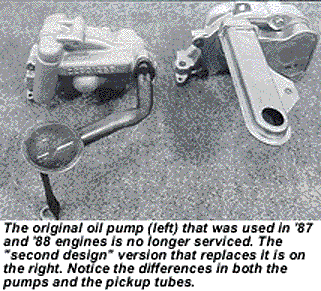
1989 VIN A (H.O.) – The H.O. engine came with the 22545690 crank. It looks like the later 25532120 casting with the 15° advance except that the notches are square-cut instead of radiused on the bottom. Some rebuilders are using the 25532120 casting with the 15° advance instead of the 22545690 in the later engines, but we prefer to use the later crank in the later engines just to be on the safe side.
1990-’94 VIN A (H.O.), VIN D and VIN 3 SOHC – All of the SOHC and DOHC motors used the 22545690 crank from ’90 through ’94.
1995 VIN D – When the balancer assembly was added in ’95, the crank was changed again. The helical gear that drove the oil pump was replaced by a chain sprocket pressed onto a hub behind the last counterweight. This crank has a 24574115 casting number on it.
1996 VIN T – The crank for the 2.4L engine has a longer stroke, narrower rod journals, a smaller, but wider reluctor wheel that has all the notches in different locations, and a chain sprocket for the balancer. It’s a 4620 casting.
RODS
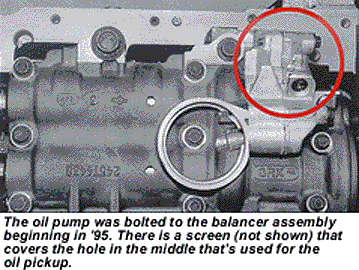 There have been three different rods used in the 2.3L Quad 4, plus the short one that was used for the 2.4L with the longer stroke. All three of the rods that were installed in the 2.3L are slightly different, but it doesn’t really matter because they can all be interchanged in sets from ’87 through ’95.
There have been three different rods used in the 2.3L Quad 4, plus the short one that was used for the 2.4L with the longer stroke. All three of the rods that were installed in the 2.3L are slightly different, but it doesn’t really matter because they can all be interchanged in sets from ’87 through ’95.
That’s good news because it’s hard to know exactly when each version was used since the parts book doesn’t agree with what we have seen in cores. Here’s how it looks today according to the GM microfiche:
1987-’89 ALL – The original rod that was used from ’87 through ’90 measured 1.086″ wide at the big end and had a pin bushing in the small end. It has “B63” cast on the shank.
1990-’95 ALL – There were two more rods used in the Quad 4 engines during these years. Both have been superseded to one part number according to the microfiche. The second version of the rod looked just like the first one, but the pin was floated in the pin bore without a bushing. It had “A94” cast on it.
The third version of the rod came without a pin bushing, too, but it had more of a rounded weight pad on the bottom. We have seen some of them in sets with “B67” on the shank, and others with four different casting numbers – A233, B233, A240 and B240 – all in one motor.
1996 VIN T – The rods for the 2.4L are about .060″ shorter than the ones for the 2.3L to help compensate for the longer stroke with the same deck height. The rod journals on the new crank are narrower, so the rods are only .915″ wide. We have seen them with A76 and B77 cast on the beam.
OIL PUMPS
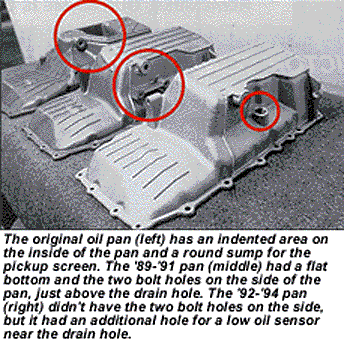 There have been three oil pumps used on the 2.3L Quad 4. The oil pump was bolted to the block and driven by a helical gear on the crank until ’95 when it became part of the balancer assembly and was driven by the secondary balance shaft.
There have been three oil pumps used on the 2.3L Quad 4. The oil pump was bolted to the block and driven by a helical gear on the crank until ’95 when it became part of the balancer assembly and was driven by the secondary balance shaft.
The original pump that was used in ’87 and part of ’88 (it’s called “first design ’88” according to GM) is no longer serviced by GM or the aftermarket. So, the revised pump that was introduced as “second design ’88” is the only one that’s available for the earlier engines. This creates a problem, because the early oil pan and fill tube will not work with the “second design” oil pump, so they both have to be replaced with the later pan and tube (for about $150) when the “second design” pump is installed.
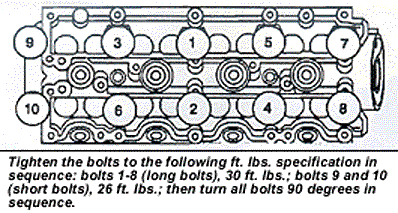 The oil pumps are easy to tell apart because the “first design” pump has an aluminum gear cover with the pickup tube bolted to the pump while the “second design” pump has a one-piece, crimped metal cover combined with the pickup tube.
The oil pumps are easy to tell apart because the “first design” pump has an aluminum gear cover with the pickup tube bolted to the pump while the “second design” pump has a one-piece, crimped metal cover combined with the pickup tube.
Starting in 1995, the gerorotor oil pump was housed in a two-piece, split aluminum housing that was bolted on the back corner of the balancer assembly. The oil is picked up through a screen (p/n 24573826) that covers the oil passage that’s located in the middle of the balancer assembly.
The ’96 oil pump appears to be similar to the ’95 version, but it has a new part number. GM had problems with excessive oil pressure caused by the relief valve sticking in the bore, so the original pump was superseded with a new version that had improved clearance for the relief valve.
OIL PANS
The Quad 4 has had a total of five oil pans, four for the 2.3L and one for the 2.4L.
1987-’88 ALL – The original pan (c/n 22531766) that was used with the “first design” oil pump had an indented area adjacent to the sump for the pickup tube and screen. This pan was designed specifically for the “first design” oil pump that’s no longer available anywhere; it must be replaced whenever the “first design” oil pump is replaced with a “second design” pump.
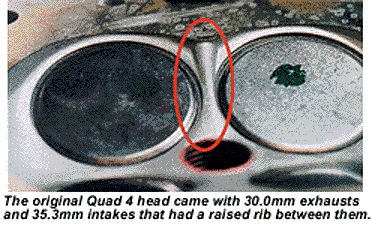 Rebuilders should be aware that there are differing opinions on the years the original pump and pan were used. The GM microfiche lists them both as ’87 and “first design ’88”, but some rebuilders say they were used all the way through ’88 while others believe that they were installed on some early ’89s. There’s no way to know for sure, but the point is, this early pan can’t be used with the “second design” oil pump; it has to be replaced whenever the “second design” pump is installed on an early engine that came with the original pump.
Rebuilders should be aware that there are differing opinions on the years the original pump and pan were used. The GM microfiche lists them both as ’87 and “first design ’88”, but some rebuilders say they were used all the way through ’88 while others believe that they were installed on some early ’89s. There’s no way to know for sure, but the point is, this early pan can’t be used with the “second design” oil pump; it has to be replaced whenever the “second design” pump is installed on an early engine that came with the original pump.
1989-’91 ALL – The “second design” oil pan has a flat bottom for the revised, “second design” oil pump. It carries a 22538921 casting number and is available from GM under the same part number for about $150.
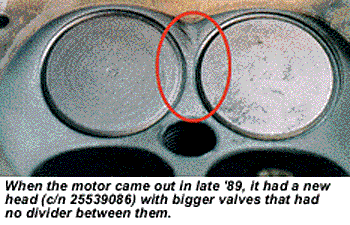
1992-’94 ALL – The oil pan was changed again in ’92. The two threaded bosses that had been on the side of the pan since ’87 were eliminated and another large hole was added by the drain hole for the low oil sensor. Both the casting number and the part number are the same; it’s a 24571250.
1995 ALL – The oil pump and screen were a part of the balancer that was added to the Quad 4 in ’95, so there’s another new oil pan that has more room for the balancer. Although we haven’t seen one, we suspect that the casting number will be the same as the part number which is a 24574440.
1996 – The 2.4L engine was virtually “all new” with a different block and a new front cover, so it’s no surprise that it also has a new oil pan. It’s a p/n 24574397, and it probably has the same number cast on the pan.
HEADS
There have been both SOHC and DOHC heads used on the Quad 4 with several variations of each due to changes in valves, ports and structural design.
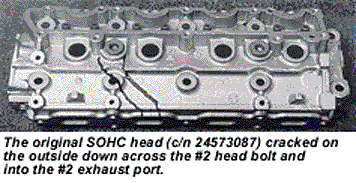
1987-’89 VIN D – The ’87 Quad 4 came with a 16-valve aluminum head that was a 22530955 casting. It had a “modified pent roof” design and siamesed ports for each chamber. The intake valves were 35.5mm and the exhaust valves were 30.0mm.
1989-’92 VIN A (H.O.) and 1990-’92 VIN D – When the H.O. motor was introduced in late ’89, it had a new head with bigger valves, along with subtle revisions to the chamber and ports to “reduce restriction and improve flow.”. The intake valves were increased from 35.5mm to 36.5mm and the exhausts went from 30.0mm to 31.5mm. This head, c/n 25539086, was also used on the VIN D engines from ’90 through ’92.
1992 VIN 3 SOHC – When the SOHC version of the Quad 4 family came out in ’92, it had an all new head with only one cam. The original 24573087 casting had a tendency to crack externally down across the second outer head bolt and down into the second exhaust port, so it was replaced by an improved design in ’93.
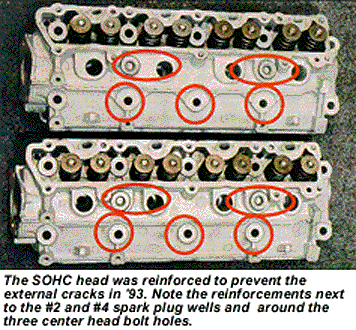
1993 VIN A (H.O.) and 1993 VIN D – The ’93 DOHC engines came with a new head that had smaller exhaust ports and two larger 10.0mm studs for the exhaust manifold. This revised head, c/n 24570753, was used on both the VIN A and VIN D applications in ’93. The service replacement is a 24573303 casting.
1993 VIN 3 SOHC – The new head for the SOHC motor had more metal around the threaded holes adjacent to two of the spark plug wells and reinforcements around the three middle head bolt bosses. These improvements kept the 24574468 casting from cracking externally.
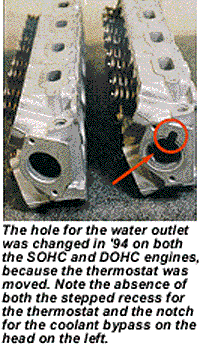
1994 VIN 3 SOHC – The SOHC head was changed one more time in ’94. It still looked the same on the outside, but it had smaller exhaust ports and a revised hole for the water outlet. The thermostat was moved to a remote location, so the notch for the coolant bypass was eliminated along with the machined step for the thermostat itself. It’s a 24573302 casting.
1994-’95 VIN D – The head for the ’94 DOHC engine had the smaller exhaust ports and the modified hole for the water outlet, just like the one on the ’94 SOHC head. It’s a 24575456 casting, and it was used in ’95, too.
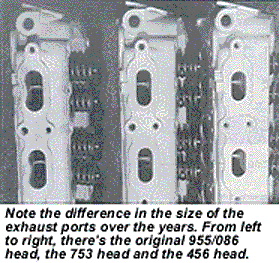
1996-’98 VIN T – The new 2.4L engine came with a different head that had several changes. The chamber was shaped more like an oval with straight sides, both the intake and exhaust valves were smaller, both the intake and exhaust ports were different, and there was an EGR crossover passage cast into the head just below the water outlet. It’s a 24574683-18 casting.
CAMS
There was only one cam used for all of the SOHC motors, but there were four pairs of cams for the 2.3L DOHC engines, depending on the year and application, plus another pair for the 2.4L. Most of them can’t be identified by the casting number alone, so rebuilders should check both the casting number and the lobe height before reusing any of these cams. The right pair of cams must be used together in the right application in order to avoid performance and emission problems.
1987-’89 VIN D DOHC – The original intake cam had a 225/309 casting number with a lobe height of .3400″. The exhaust cam was a 225/312 casting that had a lobe height of .3500″.
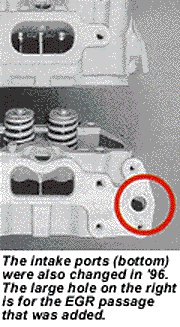
1989-’94 VIN A (H.O.) DOHC – The H.O. engines all came with a better cam that had more lift and duration. Both the intake and exhaust cams have a 225/455 casting number and a valve lift of .4100″ at the lobe.
1992-’94 VIN 3 SOHC – The single overhead cam motors all used the same cam. It has eight lobes, each in a different place, instead of the two pairs of four lobes found on the DOHC cams. Look for either 245, 704 or 78 somewhere between the first and third lobes.
1990-’94 VIN D DOHC – These cams have the same 225/455 casting number as the H.O. cams described earlier, but the lift and duration are different. The lift for both the intake and exhaust lobes measures .3750″. GM says the specs were changed “to improve idle stability.”
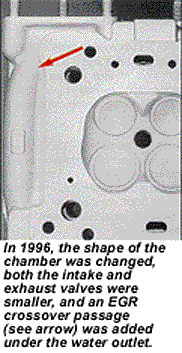
1995 VIN D DOHC – Both the intake and exhaust cams share a new 245/742 casting in ’95, so they both have a raised area about half way around the cam between the third and fourth lobe, even though it’s only needed on the intake cam for certain applications. It provides an input for the cam position sensor that bolts into the cover for the intake cam.
The signal from this sensor is used to index the sequential fuel injection found on the ’95 J cars with the 4T40-E automatic transmission. Although both cams share the same casting, it’s easy to tell them apart because the back of the intake cam is machined for the hex shaft that drives the power steering pump that’s mounted to the back of the engine. The valve lift measures .3600″ at the lobe.
1996 VIN T DOHC – Both of the cams for the 2.4L use the same castings (245/742) that were used for the ’95 VIN D cams, but the lift at the lobe is slightly less. The intake checks at .3540″ and the exhaust measures .3450″. GM says the cam was changed “to improve low end torque.”
CAM HOUSINGS
The SOHC engines came with one cam housing and the DOHC engines each had two – one for the intake and one for the exhaust. They are split in the middle and sealed by four separate molded seals that are each designed to fit into a specific groove. But, there’s a catch; the depth and location of the seal grooves was changed in ’94 so you can make a simple mistake and end up with big problems.
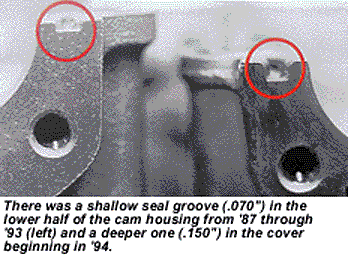
1987-’89 VIN D – These engines originally came with a 22535436 intake cam housing cover and a 22535435 exhaust cam housing cover. The lower halves of both housings each have a different casting number. Both the upper and lower housings were sand castings. The seal grooves for both the intake and exhaust are in the lower half of the housing and measure .070″ deep.
1989-’93 VIN A (H.O.) and 1990-’93 VIN D – The original cam housings were replaced by another pair that were die castings. The intake cover was a 22542961 and the exhaust cover was a 22542963. Both still had the shallow, .070″ seal groove in the lower half of the housing.
1992-’93 VIN 3 SOHC – The SOHC engine had its own special cam housing. The cover has a 24572808 casting number on it. The shallow seal groove was in the lower half of the housing.
1994 VIN A (H.O.) and VIN D – There were two important changes made to the cam housings in ’94: 1) The seal grooves were moved from the bottom of the cam housings to the covers that bolted on the top; and 2) they were considerably deeper (.150″), so they required thicker seals. The top edges of the lower housings were left “as cast” in ’94. We don’t have casting numbers, but they can be identified by the deep grooves in the cover along with the unmachined mating surfaces on the lower halves.
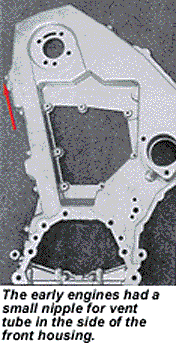
1994 VIN 3 SOHC – The seal groove was apparently moved to the top cover of the cam housing assembly for the SOHC in ’94, too, because the part number for the housing assembly changed along with the part number for the seals. It would be best to check it so you don’t mix and match the wrong pieces.
1995 VIN D and ’96 VIN T – There were three changes made to the cam housings in ’95: 1) The power steering was driven directly off the intake cam so there were two new bosses on the end of the housing; 2) The bores for the lifters were smaller (33.0mm); and 3) There was a boss cast on the intake cover that could be drilled for the cam position sensor and a holddown.
These holes may or may not be drilled, depending on whether or not the car had sequential fuel injection. All of the ’96s had SEFI, but only the “J” cars with the 4T40-E automatic transmission had it in ’95. The intake cover was a 24574057 casting and the exhaust was a 24572810 casting.
FRONT HOUSINGS
There have been several housings and front covers used on the Quad 4 engine. The location of the dowels for the front cover have changed along with the hole for the vent tube. No one claims to know exactly what GM did, however, these combinations seem to be right most of the time. Start here and be sure to double check it before you sell the engine.
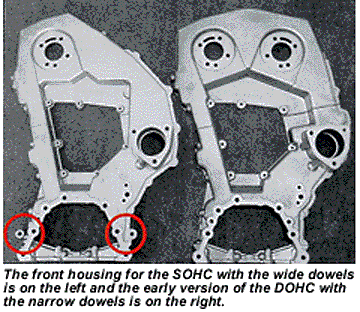
1987-’89 VIN D – The front housing has a small nipple on the driver’s side for a vent tube and there is no tube on the front cover. The dowels for the front cover are located on the inside of the housing. There were at least two different castings that came with and without the vent hole drilled, so be sure to find a 22547879, a 22534007 or a similar casting with the hole and nipple.
1989-’91 VIN A (H.O.), 1990-’91 VIN D – The front housing came without a nipple so there was a large vent tube on the front cover. The dowels are still toward the inside of the housing. Look for either a 22547879, a 22534007, or a similar casting without the nipple. Use it with the front cover that has the big vent tube on the front.
1992-’94 VIN A (H.O.) and VIN D – The front housing was changed along with the chain and tensioner in ’92. It’s a 24570408 casting. The dowels for the front cover are on the outside edge of the housing. There is no vent tube in the housing, but there is one on the front cover.
1992-’94 VIN 3 SOHC – The single overhead cam engines had their own special front housing and cover. The housing is a 24570263 casting with wide dowels on the outside of the housing and no vent tube. The front cover had the big vent tube.
1995 VIN D – The ’95 balancer motor came with another new cover. It’s a 24574164 casting. It has the wide dowels and a bigger, angled hole for the vent tube. The front cover doesn’t have a vent tube.
1996 VIN T – The 2.4L has another all new cover. It still has the bigger, angled hole for the vent tube, but there are several other differences including a large threaded hole for the oil filler cap. It’s a casting number 24574741. The front cover comes without a vent tube.
CHAINS AND TENSIONERS
There have been two different timing chains and tensioners used for the DOHC, along with another version for the SOHC.
1987-’91 DOHC – These engines came with a double-roller timing chain and a tensioner that had a separate, replaceable shoe.
1992-’96 DOHC – Olds used a link-style timing chain with powdered metal gears on these engines along with a modular tensioner that had the shoe attached to it. Handle the tensioner with care when you remove it from the engine so you don’t dislodge or damage the internal relief valve that’s located in the tensioner itself. It can be reused if the shoe isn’t too badly worn.
1992-’94 SOHC – All of these engines came with the link chain and the modular tensioner. The chain was shorter because the engine only had one cam gear.
That’s the story on the bits and pieces. The chart shows how the block, crank and heads all fit together, but there are still some things every rebuilder should know about the Quad 4 in order to save time and money:

H.O. ENGINES
The H.O. engines make more power because they have more compression (10.0:1 versus 9.5:1), better cams with more lift and duration, and the best head available at the time.
HEADS
•All of the Quad 4 heads tend to crack in the chambers. The early SOHC head cracks on the outside, too, so check all of them over carefully and expect to do a lot of welding.
•It’s almost impossible to get the spark plugs out without using an impact wrench and stripping the threads in the process, so plan on installing some thread inserts.
•The valve springs were all conical-shaped through ’95. They were changed to a tapered, bee hive design in ’96.
•The heads can’t be machined very much. The minimum thickness at the front of the head measured from the deck surface to the face of the bolt boss is 2.260″.
•These head gaskets are very prone to leakage. GM has released several different head gaskets for the Quad 4 and changed the torque sequence more than once. We recommend using only graphite head gaskets along with new bolts and holes which have been thoroughly cleaned. Follow these steps:
•Clean the threads for head bolt holes thoroughly, but don’t retap them;
•Make sure there isn’t any oil, antifreeze or debris left in th













